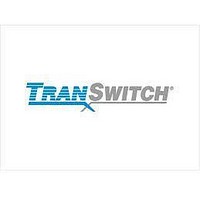TXC-05802AIPQ Transwitch Corporation, TXC-05802AIPQ Datasheet - Page 7

TXC-05802AIPQ
Manufacturer Part Number
TXC-05802AIPQ
Description
Manufacturer
Transwitch Corporation
Datasheet
1.TXC-05802AIPQ.pdf
(92 pages)
Specifications of TXC-05802AIPQ
Operating Supply Voltage (typ)
3.3/5V
Operating Temperature Classification
Industrial
Package Type
PQFP
Mounting
Surface Mount
Pin Count
208
Lead Free Status / Rohs Status
Not Compliant
The CellBus bus has a framed format 16 clock cycles long and 32 bits wide, which is illustrated in Figure 3. The
first cycle of each frame is the Request cycle (Cycle 0), during which those CUBIT-Pros which have a cell to
send to the bus each make an access request by asserting one or two assigned bits on the bus. The CBF,
CBACK and CBCONG signals are asserted during a Request cycle. The device address assigned to each
CUBIT- Pro by device straps (UA(4-0) at pins 2-6) uniquely specifies which two bits it may assert during the bus
Request cycle time. For example, UA(4-0) = HHHHH selects bits 1a and 1b. By asserting one of its assigned
bits, or the other, or both, access requests of three different priorities may be made (controlled via bits P1, P0
in memory address 0AH). A central Bus Arbiter accepts these access requests, executes an arbitration algo-
rithm (highest priority served first, round-robin within each priority), and issues a bus access grant during the
final cycle of the frame, the Grant cycle (Cycle 15). Each grant issued by the arbiter is for one CUBIT- Pro to
send one cell to the bus. Whichever CUBIT- Pro is issued a grant during a Grant cycle will transmit its cell dur-
ing the 14 Cell Body clock cycles of the next bus frame, and will also drive an 8-bit cell parity check during the
Grant cycle of that bus frame. Each cell sent can be of unicast, multicast, or broadcast type. CUBIT-Pros will
accept single-address cells routed to an address defined by their address straps, all broadcast cells, and
selected multicast cells. Thus, cells may be sent from any one CUBIT- Pro to any one CUBIT- Pro or to multiple
CUBIT-Pros.
The CUBIT- Pro can be operated in either 16-user or 32-user mode, selectable via the U32 pin, as shown in
Figure 4. For the 16-user mode the CellBus bus frame is identical to Figure 3. However, in 32-user mode the
frame is duplicated, so that an odd and even frame are provided. The distinction between the two frames is
given by the location of the frame pulse. The cycles for both frames are the same, except for the meaning of
the Request cycle. The Request cycle in the even frame coincides with the frame pulse, whereas in the odd
frame the pulse is not present. Furthermore, in the even frame CUBIT-Pros 0-15 (lower 16 users) request
access to the bus and in the odd frame CUBIT-Pros 16-31 (upper 16 users) request access to the bus. The full
bus bandwidth is available to be shared among all the users on the bus in either 16 or 32-user mode.
(14 cycles)
Request
Grant
Body
Cell
Number
Cycle
10
11
12
13
14
15
0
1
2
3
4
5
6
7
8
9
16
31
b
GFC
16
a
15
Byte 12
Byte 16
Byte 20
Byte 24
Byte 28
Byte 32
Byte 36
Byte 40
Byte 44
b
Byte 0
Byte 4
Byte 8
BIP-8
Figure 3. CellBus Bus Frame Format
15
CellBus Routing Header
a
14
b
14
a
13
b
13
VPI
a
12
b
12
a
11
Byte 13
Byte 17
Byte 21
Byte 25
Byte 29
Byte 33
Byte 37
Byte 41
Byte 45
b
Byte 1
Byte 5
Byte 9
11
a
- 7 -
10
b
10
a
9
b
16 15
Unused
9
a
8
b
Tandem Routing Header (Optional)
8
a
Byte 10
Byte 14
Byte 18
Byte 22
Byte 26
Byte 30
Byte 34
Byte 38
Byte 42
Byte 46
7
b
Byte 2
Byte 6
VCI
7
a
6
b
6
a
5
b
5
a
4
b
4
a
Byte 11
Byte 15
Byte 19
Byte 23
Byte 27
Byte 31
Byte 35
Byte 39
Byte 43
Byte 47
3
b
G
P
R
Byte 3
Byte 7
3
a
G
E
N
2
b
Terminal
Granted
PT
Number
2
a
1
b
0
1
a
C
P
L
Ed. 3, November 1999
TXC-05802
CUBIT- Pro
TXC-05802-MB











